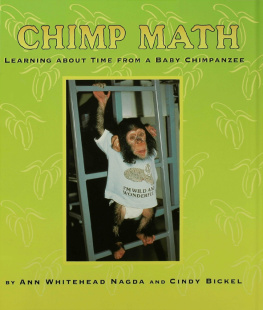Contents
Guide
T. J. is a Siberian tiger cub born at the Denver Zoo. One day he stops eating. The zoo staff tries to tempt him with treats, but he refuses them all. The staff doesnt give up, and finally their love and persistence pay off. T.J. grows up to be a huge, healthy tiger.
The delightful pictures of T.J. and the heartwarming story of his life will charm young readers as they learn the basics of graphing.

T.J. S FAVORITE BALL .

D RAGGING BOOTS AROUND IS TIRING .

P OSING FOR THE CAMERA .

T.J. BLENDS IN WITH LEAVES AND GRASS WHEN HE HIDES .
TIGER MATH
L EARNING TO G RAPH FROM A B ABY T IGER
BY A NN W HITEHEAD N AGDA
AND C INDY B ICKEL

Henry Holt and Company
New York
The author and publisher have provided this e-book to you for your personal use only. You may not make this e-book publicly available in any way. Copyright infringement is against the law. If you believe the copy of this e-book you are reading infringes on the authors copyright, please notify the publisher at: us.macmillanusa.com/piracy.
For my fatherA. W. N.
For Steve, my husbandC. B.
Henry Holt and Company, LLC
Publishers since 1866
175 Fifth Avenue
New York, New York 10010
www.henryholtchildrensbooks.com
Henry Holt is a registered trademark of Henry Holt and Company, LLC.
Text and story concept 2000 by Ann Whitehead Nagda
Photographs 2000 by the Denver Zoological Foundation, Inc.
All rights reserved. Distributed in Canada by H. B. Fenn and Company Ltd.
Photo credits: All images by Cindy Bickel with the following exceptions: John Edwards, ;
Ann Nagda, .
Library of Congress Cataloging-in-Publication Data
Nagda, Ann Whitehead.
Tiger math: learning to graph from a baby tiger/by Ann Whitehead Nagda and Cindy Bickel.
Summary: Describes by means of words and graphs the growth of an orphan Siberian tiger cub.
1. Graphic methodsJuvenile literature. 2. TigersJuvenile literature.
[1. Graphic methods. 2. Tigers. 3. AnimalsInfancy.]
I. Bickel, Cindy. II. Title.
QA90.N26 2000 511.5dc21 99-46686
ISBN-13: 978-0-8050-6248-9/ISBN-10: 0-8050-6248-3 (hardcover)
7 9 10 8
ISBN-13: 978-0-8050-7161-0/ISBN-10: 0-8050-7161-X (paperback)
3 5 7 9 10 8 6 4 2
eISBN: 978-4668-6722-2
First published in hardcover by Henry Holt and Company
First paperback edition2002

We are grateful for the cooperation of the Denver Zoo, Denver, Colorado.

H OW MANY BALLS CAN ONE TIGER CUB DESTROY ? A S MANY AS YOU GIVE HIM .

T.J., THE BABY TIGER .
I NTRODUCTION
It is a very special event when a Siberian tiger is born, because there are so few of them left in the world. This book will use graphs to help tell the story of T.J., a Siberian tiger cub born at the Denver Zoo. Just as words can tell a story, so can graphs. Graphs are math pictures that make it easy to see and understand information about numbers. This book will introduce four different kinds of graphs: picture graphs, circle graphs, bar graphs, and line graphs.

Picture graphs use pictures to make it easy to compare things. The image above is a picture graph that shows how many tigers are left in the wild. Each tiger drawing stands for 500 tigers. To read this graph, choose a kind of tiger from the names along the bottom. Then count how many tiger drawings are in that tigers column and multiply that number by 500. This graph makes it easy to see that there are fewer Sumatran and Siberian tigers than there are other kinds of tigers.

T.J., THE TIGER CUB, AND B UHKRA, HIS MOTHER .
Buhkra, the Siberian tiger, was going to have a baby. The keepers at the Denver Zoo had already placed a video camera in her den, so they could check on the mother tiger without disturbing her. When the cub was born, they watched Buhkra and her baby on a TV screen. Buhkra was a good mother, licking, nuzzling, and nursing her new baby. The cub, named T.J., weighed only three pounds and looked tiny next to his mother, who weighed 250 pounds. T.J.s father, Matthew, was even bigger than Buhkra. He weighed 350 pounds. T.J. would have to gain a lot of weight to be as big as his father.
T IGERS IN THE W ILD

Another way to show how many tigers are left in the wild is to use a circle graph. A circle graph, or pie chart, shows what part of a whole something is. The whole circle represents all the tigers left in the world. This graph makes it easy to see that there are a lot of Bengal tigers and very few South China tigers. There are so few South China tigers left that they couldnt be shown on they would have been just a small piece of a tiger picture.

M ATTHEW , T.J. S FATHER, WEIGHS 350 POUNDS .
When T.J. was six weeks old, the zoo veterinarian gave him shots and weighed him. The cub weighed ten pounds. When T.J.s father was six weeks old, he weighed fourteen pounds, four pounds more than T.J. Even so, the little tiger was healthy and strong. Sheila, the tiger keeper, had trouble holding him still while the vet examined him. The feisty little cub never stopped wriggling until Sheila brought him back to his mother.

A picture graph can be used to show T.J.s weight. This is a picture graph like the one . On this graph, blocks are used instead of pictures of tigers. Each block is equal to one pound. Each column shows T.J.s weight at a particular age.




























